This post explains how to securely lock a bicycle – so it is safe when left outside, unattended. What to look out for, how to do it properly. A separate post gives some practical ideas for storing a bicycle indoors (inside a flat is definitely safer than in the street).
Table Of Contents (T.O.C.):
- Bicycle thefts
- Locking a bicycle
2.1. Location
2.2. Bicycle – looks
2.3. Locking method - Bicycle locks – types
- Note
1. Bicycle thefts
Often people get put off using bicycles as a means of transport by bicycle thefts. Bicycle safety is like an anecdote of two men walking the desert, one carrying a pair of running shoes in “case a lion shows up”. His friend asks him if he thinks he’ll outrun a lion. He replies: “I just need to outrun you”. 🙂
As long as your bicycle is cheaper (looking) than other bicycles and locked better than other bicycles, it is quite safe. This post gives advice on locking techniques. For advice on how to choose a good lock, take a look here: Bicycle locks.
2. Locking a bicycle
The point of locking a bicycle is not to make it impossible to be stolen – such locks don’t exist. It is important just to make it not worth the bother to thieves – because there is a lot of easier prey in the street. How to achieve that?
2.1. Location
If the bicycle can’t be carried along all the time, it is best left in a crowded, lit, public place. Backyard or a building corridor are places where thieves can work easily, hearing and seeing if anyone is approaching. A corridor in front of a flat is one of the worst places to lock a bike.
Apart from those, perhaps the most dangerous place is “just for a minute“. Bike left just for a minute, unlocked, even if in the site of the owner is easy to sit on and ride off. It happens. Entering a shop for a second, or carrying a load and leaning the bike against a wall, just to put the load in the gateway (or in a car), are also situations that thieves often use.
2.2. Bicycle – looks
If the bike is expensive or looks expensive, with disc brakes, shock absorbers, leather saddle, or other sought-after parts, the risk of theft is higher. Clean, neat-looking bicycles that catch the eye are more likely to get stolen.
2.3. Locking method
A key point. If a bicycle is locked so that it can easily be carried away and then have locks open at one’s convenience, it is an easy target. Always make sure the bicycle frame is locked to an object that is not easier to cut than the lock itself.
POOR bicycle locking technique:
- Thin metal on some bicycle parkings that can easily be cut is a bad idea. Make sure the frame is locked to a sturdy, hard-to-hack post or a tree.
- Locking wheels to the frame so that they can’t turn, but not locking the frame to a post or something. The bicycle can easily be carried away, and its locks opened at one’s convenience at home.
- Locking just wheels, not the frame itself, to a post or a tree. Wheels are simply taken off and left, while the rest of the bike is carried away.
- Locking the frame but leaving the chain close to the ground. Ground provides lots of leverage for different cutting tools. Keep locks as high as possible.
- Having too long, too wide locks and padlocks, leaving room to insert leverage metal bars, car lifting jacks etc. – is also a bad idea.
Here are a few examples of poorly locked bicycles:
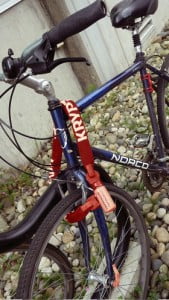




This lock was placed some 20 cm above the ground.
GOOD bicycle locking technique:
- Lock the frame to a strong immobile object, putting the lock through the frame so that it can’t be taken off without cutting the frame (or the lock).
- Lock both wheels (to the frame or an immobile object).
- Make sure the saddle and other expensive parts are either taken off, or locked to the frame.
It is practical to have one strong, sturdy, heavy lock to lock the frame (and a wheel too) to a post, then use a cable to lock the other wheel.
The saddle can always remain chained to the frame, wherever the bike is ridden.
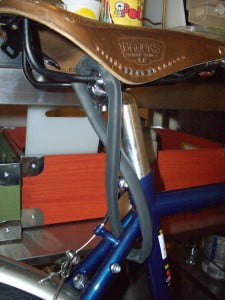
The chain is stored in a plastic/rubber tube to prevent noise and scratching the frame.
Here are some examples of well-locked bicycles:
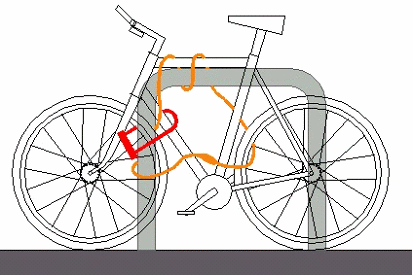
The front wheel and the frame are locked to the post with a U-lock, while the rear wheel is locked with a cable.
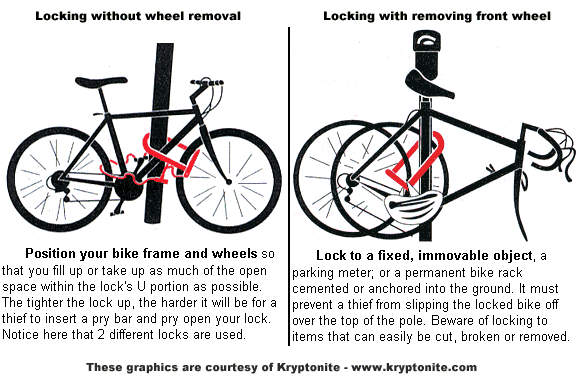
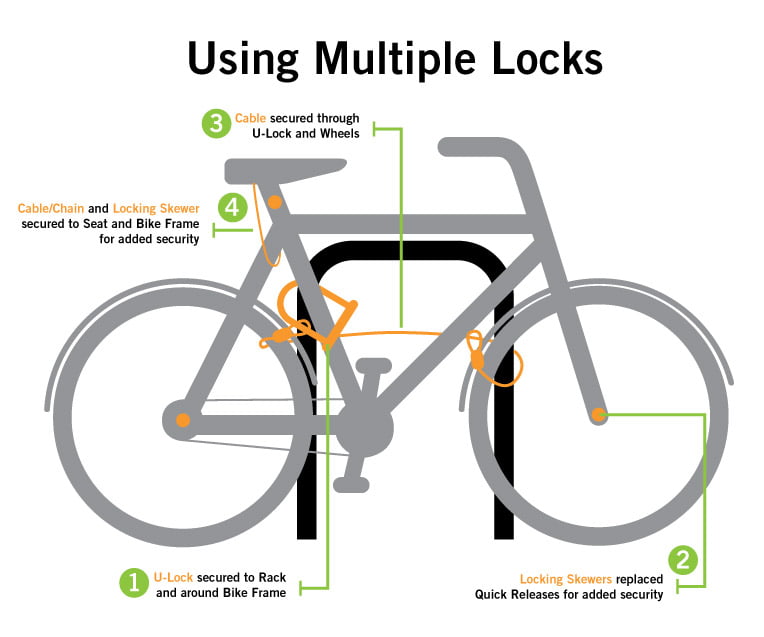
Good locking technique makes the job difficult for thieves. To steal anything valuable from the bike, they have to cut at least one lock/cable.
If a U-lock is used, ensure there is no free room left – if it’s a long one, lock both frame and a wheel. So that a car lifting jack can not be put inside.


In the case of a very small U-lock, one could lock just the rear wheel to a post, but through the bicycle’s rear triangle. This makes it impossible to remove the rear wheel without cutting the lock, the frame, or the rear wheel rim. Cutting a wheel rim is a tedious job (remove tyre, tube, cut the whole rim in a tight place…).
I read about this method from the late legend Sheldon Brown (his website link).
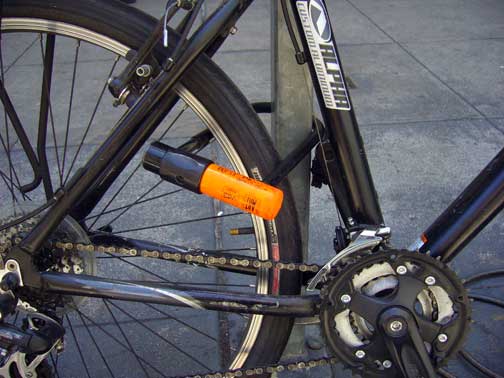
Just as long as the rim is locked by the section INSIDE the rear triangle of the frame.
3. Bicycle locks – types
There are several basic lock types:
- Chain (and a padlock)
- U-lock
- Cable (with or without its own lock)
- Folding lock

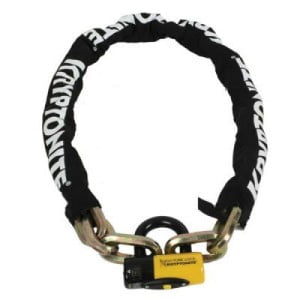

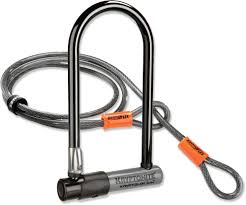
All the lock types are good. If one carries two locks, it is a good idea to combine a cable with one of the other 3 types. This is because it takes different kinds of tools for those locks: cables are usually cut, while the others are sawn, or broken (or cut if they are too thin, which is explained in the Bicycle locks article.).
4. Note
Even a well-locked bicycle with a good lock takes just about 20 minutes to hack. If the thief uses a battery-powered angle grinder, it is just a few minutes. So no method is 100% safe. However, if the bike is better locked than the other bikes in the street and it doesn’t look more expensive, there is a much greater chance it will wait for you where you left it.
In contrast, cheap bad locks and poorly locked bicycles are taken within a minute or less, with ordinary tools every small thief has, or even without any tools.

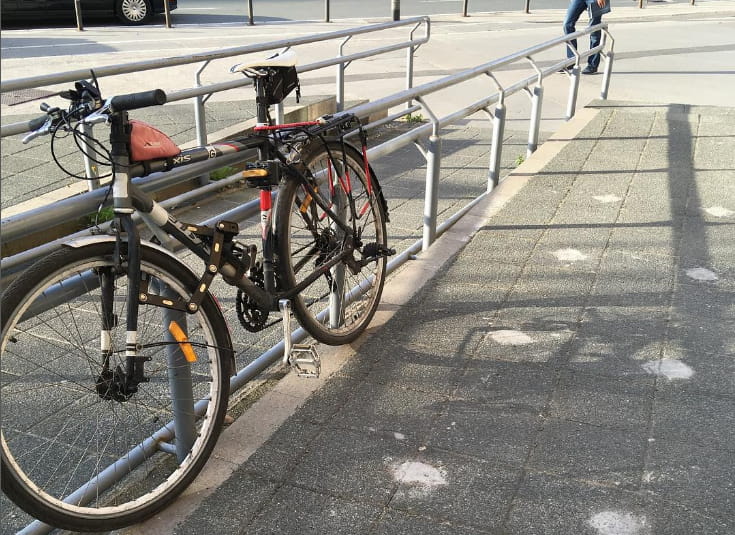
“In case a U-lock is used, make sure there is no free room left – if it’s a long one, lock both frame and a wheel. So that a car lifting jack can not be put inside.”
I would like to add that the rear wheel is preferable to the front because it is more expensive.
Ideally lock frame and both wheels, if this is not possible, then better frame and rear wheel than frame and front wheel, but at least the frame.